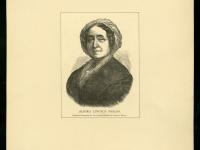If you are looking for more examples of exceptional women to spruce up your curriculum, consider a couple of the collections at HSP that are focused on women who broke traditional boundaries. The two examples of women below are individuals who were pioneers in their respective fields and advocates in the fight for equal rights.
First, Almira Hart Lincoln Phelps wrote textbooks in the early 1800s, such as Chemistry for Beginners, Botany for Beginners, and Familiar Lectures on Botany. Her goal was to make sure female education was comparable to male education, even before the women’s rights movement, and she taught female students for decades using her own methods and published textbooks. These textbooks, and others used by women, can be found within HSP’s collections and work as a fantastic teaching tool for a variety of subjects due to their focus on poetry in conjunction with scientific classification, as well as their hands-on activities, such as creating a herbarium. You can visit her collections here and even check out some of her digitized work.
Another example is Caroline Katzenstein, a Philadelphia native who made a significant difference in the lives of women as a vocal women’s rights suffragette. Even after women gained the right to vote in 1920, Caroline did not stop advocating for equality. Rather, she went on to campaign for the Women’s Teachers Organization for equal pay and then took up the cause of the Equal Rights Amendment (ERA), for which she lobbied over forty years. In 1955, she even wrote a book called Lifting the Curtain that sheds light on the history of suffrage and women’s labor rights in Pennsylvania.
It is important for students to be aware of women such as Caroline and Almira because it shows that women did not sit idly by as passive figures in history. Instead, they fought for equal rights with men through education and the workplace. If you have any questions about where to find more information on either of these women, please contact us.

